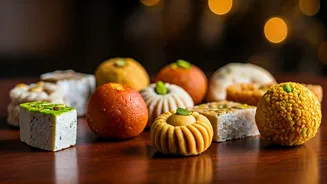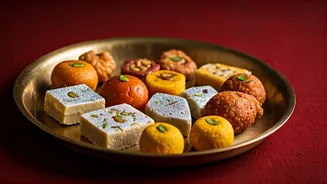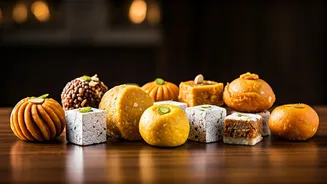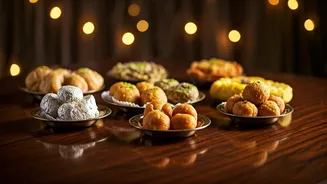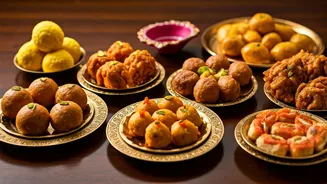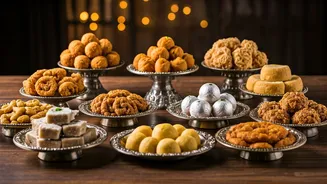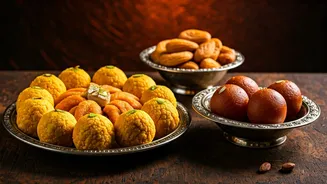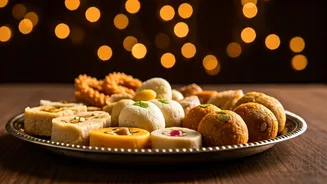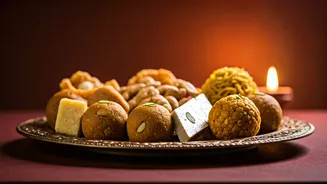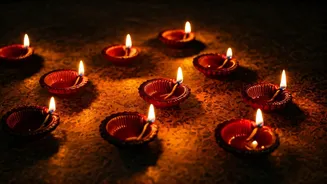Sweet Offerings
The cornerstone of Diwali celebrations involves sweets, symbolizing sweetness and happiness in life. Ladoos, particularly Motichoor Ladoos, are a must-have.
Their round shape represents wholeness and the sun. Then comes the sweet Malpua, a pancake-like dessert that’s deep-fried and soaked in sugar syrup, often offered to Lakshmi. Another is Kheer, a creamy rice pudding often flavored with cardamom, nuts, and saffron, symbolizing purity and prosperity. Finally, the Gulab Jamun, deep-fried milk balls in a sweet syrup, are also very popular. These sweets are not only delicious but also represent the sweetness and joy the festival brings.
Savory Dishes
Besides sweets, savory items are also central to the Diwali feast. The savory offerings are a balance to the sweetness and add a satisfying element to the meal. First, the Kachori, a deep-fried pastry filled with spiced lentils or potatoes, provides a burst of flavor and texture. Then, comes the Samosa, a fried or baked pastry with a savory filling, typically spiced potatoes, onions, peas, and lentils. Besides this, the Puri-Bhaji, a deep-fried bread served with a spiced vegetable curry is essential to the meal. The savory dishes are designed to complement the sweetness of the other offerings, creating a harmonious balance.
Fruits and Nuts
Fruits and nuts represent abundance and prosperity, making them essential offerings during Diwali. Fruits, especially seasonal ones like pomegranates and mangoes, are often placed before the deities as a symbol of harvest and prosperity. These fresh fruits also add a refreshing and light element to the festive meal. Similarly, nuts, such as almonds, cashews, pistachios, and walnuts, are considered auspicious and are often included in the offerings. They symbolize wealth and health, aligning with the spirit of the festival. This combination of fruits and nuts not only adds nutrition but also a visual richness to the Diwali celebrations.
The Significance
The foods offered during Diwali are more than just culinary delights; they are symbolic expressions of faith, gratitude, and the desire for prosperity. Each item carries a special meaning, representing various aspects of life that devotees seek to celebrate and enhance. The offering of these foods to Lakshmi and Ganesha is a way of inviting blessings for a prosperous and happy year ahead. The act of sharing these meals with family and friends strengthens bonds and creates a sense of togetherness, which is a key part of the festival. Thus, the selection of these foods is carefully considered to align with the core values of Diwali.
Preparation Tips
Preparing traditional Diwali foods can seem daunting, but careful planning and preparation can make the process enjoyable. Begin by planning the menu a few days in advance, listing all the ingredients needed and making a shopping list. Prepare the doughs and fillings for dishes like samosas and kachoris a day ahead to save time. If making sweets like ladoos or kheer, ensure that you have the right quality of ingredients, such as good quality ghee and fresh milk. On the day of the festival, allocate time for cooking different items, starting with those that take the longest. Remember to enjoy the process, involving family members, and making it a shared experience.
Serving and Presentation
The presentation of Diwali food adds to the festive ambiance and enhances the dining experience. Arrange the sweets and savories in an attractive manner. Use decorative platters, bowls, and serving dishes that complement the festive theme. Garnishing dishes with fresh herbs, nuts, and edible flowers adds visual appeal. Create a visually balanced spread that includes a variety of colors, textures, and flavors. When serving, ensure that everything is presented in a clean and organized manner. The presentation should be a reflection of the love and care you put into the food, making the dining experience even more special for everyone involved.
Dietary Considerations
While the focus is on traditional foods, dietary needs can be incorporated into the Diwali celebrations. For those with dietary restrictions, like those who are gluten-free, substitute wheat-based items with alternative grains or flours like rice flour or almond flour. Similarly, for those who are vegan or vegetarian, use plant-based milk or ghee alternatives in the preparations. For those watching their sugar intake, explore sugar-free alternatives for sweets, using natural sweeteners like dates or jaggery. Labeling dishes with their ingredients can also help guests make informed choices. Adapting the menu to suit these dietary considerations ensures everyone can enjoy the festivities without compromising their health or preferences.
Food Safety
Maintaining food safety is crucial during Diwali celebrations, especially when preparing large quantities of food. Before cooking, wash your hands thoroughly, and ensure that all cooking surfaces and utensils are clean and sanitized. Cook foods at the correct temperature, ensuring that meat and poultry are thoroughly cooked to prevent any foodborne illnesses. Store cooked food in the refrigerator promptly, and avoid leaving food at room temperature for extended periods. When reheating food, make sure it is heated to a high enough temperature to kill any potential bacteria. By adhering to food safety guidelines, you can ensure that the Diwali feast is not only delicious but also safe for everyone to enjoy.
The Perfect Diwali
Incorporating these 9 food items into your Diwali celebrations is a wonderful way to honor Goddess Lakshmi and Lord Ganesha while enjoying the festivities. Whether you are a seasoned cook or a novice, planning, preparing, and presenting these foods adds a layer of depth to your celebrations. By following the tips provided, you can enhance your Diwali experience, making it memorable for yourself and your loved ones. Remember, Diwali is about togetherness, celebration, and joy. These traditional foods will undoubtedly enhance the spirit of the occasion, spreading happiness and prosperity to everyone involved.


